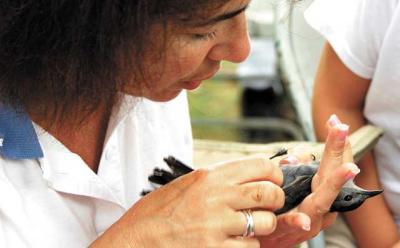Climate Change Alters Nature's Song

On July 10, Nicole Maher assisted two women researchers sitting at a white folding table in the Mashomack Preserve on Shelter Island as they inserted needles into the veins of woodland songbirds and sucked out blood samples equal to 1 percent of their body weight. Some birds squawked, but mainly they complied, lying calmly with wings fanned out as the women also blew on their underbellies to determine each bird's sex, plucked molted tail and wing feathers, and flipped them upside down on a scale in a prescription pill bottle.
Once a year, the directors from the Biodiversity Research Institute team up with Dr. Maher, a senior coastal scientist at the Nature Conservancy, to conduct mercury testing in songbirds, including robins and gray catbirds, up and down the East Coast, with several sites on Long Island. Dr. Maher specializes in marsh studies and does the same kind of mercury testing with salt marsh birds.
The five-year project, now in its third year, came about in response to the impacts of air pollution on the environment. Coal plants emit 50 tons of mercury each year, according to 2011 numbers by the Environmental Protection Agency and outlined in a report by the Nature Conservancy. Dr. Maher hopes to see reductions from a provision in the New York State Mercury Thermostat Collection Act of 2013. But she's now nervous that global warming may spur these neurotoxin levels in the marshes, which could have implications on human health and wipe out the birds.
"We're concerned that as these marshes get lower, the mercury will increase," she said.
There are two ways global warming could affect mercury availability in marshes. First, as the water temperatures warm, the metabolic rate of baitfish, which feed on bugs, intensifies and they consume greater amounts of mercury. Flounder and fluke eat baitfish, and the mercury keeps moving through the food chain until it reaches humans. Songbirds, which also feed on insects, could be prone to the same fate as the baitfish.
Second, sea-level rise could make marshes soggier and exacerbate methylmercury, a form of mercury that is stored in fat, not water, and the most problematic kind. This type of mercury also travels up the food chain and remains in the body. If the salt marshes cannot keep up with the rising waters, they could become bogged down and unable to drain, lead to higher levels of methyl mercury.
Sea-level rise due to global warming is a growing issue, especially for Long Island, and the marshes in particular are at risk.
Dr. Maher called the Northeast a "hotbed" for sea-level rise and said the area is expected to experience two to three times the rate of the global average. By the 2050s, Long Island's south shore could see a 16 to 30-inch rise in sea level.
As water levels rise, and as storms become more frequent, it is likely that the songbirds' nests will flood during high spring tides. This year, while conducting this same mercury testing at Pine Neck on Long Island, the researchers did not catch any babies, indicating the possibility that no birds hatched this year.
Over the years, Biodiversity Research Institute and the Nature Conservancy discovered the highest mercury rates in New York at North Cinder Island and Crow Island in Hempstead. From 2008 to 2013, the average blood THg was 1.3 and 1.4 parts per million respectively, which is classified as a "very high" risk level. There is an incinerator near Hempstead where people toss their old thermostats containing mercury. Accabonac Harbor showed fairly high signs of mercury as well, with an average of about 1.2 parts per million, the threshold that tips birds into a 20 to 30-percent reduction in nest success.
The average numbers for Pine Neck revealed just below 1.2 parts per million. The birds' blood samples indicate current mercury levels and the tail feathers reveal levels from their winter months spent in the Carolinas. The blood mercury levels greatly exceeded the tail feather levels, showing that the issue remains prominent in the Northeast.
While the mercury levels in songbirds might not directly threaten human life the way other impacts of climate change are predicted to, Dr. Maher lamented that any impact on the songbirds would reduce the beauty and diversity of the ecosystems. There is even talk of putting the birds on the endangered species list.
The repercussions of elevated mercury levels in the food chain, however, have sparked worry for residents.
"I think people along the coast who do include fish as part of their diet are more and more aware of mercury as a contaminant of concern," she said.
She said if scientists could prove mercury levels in birds cause reduction in nesting success, then the consequences for wildlife that relies on marshes is pretty clear.
